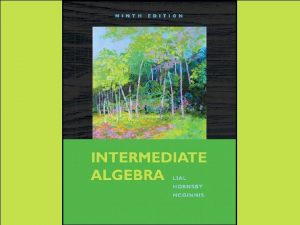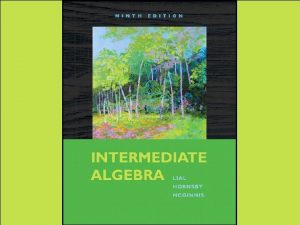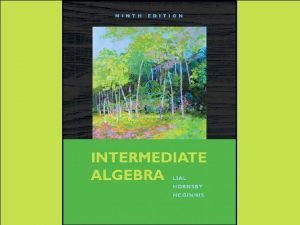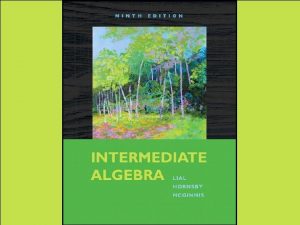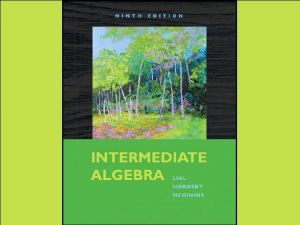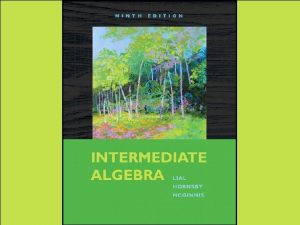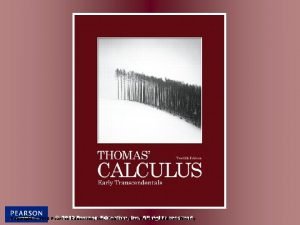Copyright 2010 Pearson Education Inc All rights reserved





























- Slides: 29

Copyright © 2010 Pearson Education, Inc. All rights reserved Sec 2. 1 - 1

Chapter 2 Linear Equations and Applications Copyright © 2010 Pearson Education, Inc. All rights reserved Sec 2. 1 - 2

2. 1 Linear Equations in One Variable Copyright © 2010 Pearson Education, Inc. All rights reserved Sec 2. 1 - 3

2. 1 Linear Equations in One Variable Objectives 1. 2. 3. 4. 5. Decide whether a number is a solution of a linear equation. Solve linear equations using the addition and multiplication properties of equality. Solve linear equations using the distributive property. Solve linear equations with fractions or decimals. Identify conditional equations, contradictions, and identities. Copyright © 2010 Pearson Education, Inc. All rights reserved. 4

2. 1 Using Linear Equations of One Variable Algebraic Expressions vs. Equations In the previous chapter, we looked at algebraic expressions: – 9 y + 5, 10 k, and Equations are statements that two algebraic expressions are equal: 3 x – 13 = 29, 2 + y = – 11, and 3 m = 4 m – 2 An equation always contains an equals sign, but an expression does not. Copyright © 2010 Pearson Education, Inc. All rights reserved. 5

2. 1 Using Linear Equations of One Variable Linear Equations in One Variable Linear Equation in One Variable A linear equation in one variable can be written in the form Ax + B = C where A, B, and C are real numbers, with A =/ 0. A linear equation is also called a first-degree equation since the greatest power on the variable is one. 5 x + 10 = 13 Copyright © 2010 Pearson Education, Inc. All rights reserved. 6

2. 1 Using Linear Equations of One Variable Linear Equations in One Variable Determine whether the following equations are linear or nonlinear. 8 x + 3 = – 9 Yes, x is raised to the first power. 9 x – 8 = 15 No, x is not raised to the first power. 7 = – 12 x No, x is not raised to the first power. 3 No, x is not raised to the first power. Copyright © 2010 Pearson Education, Inc. All rights reserved. 7

2. 1 Using Linear Equations of One Variable Deciding Whether a Number is a Solution If a variable can be replaced by a real number that makes the equation a true statement, then that number is a solution of the equation, x – 10 = 3. 13 is a solution 8 is not a solution 13 8 x – 10 = 3 13 – 10 = 3 (true) 8 – 10 = 3 Copyright © 2010 Pearson Education, Inc. All rights reserved. (false) 8

2. 1 Using Linear Equations of One Variable Finding the Solution Set of an Equation An equation is solved by finding its solution set – the set of all solutions. The solution set of x – 10 = 3 is {13}. Equivalent equations are equations that have the same solution set. These are equivalent equations since they all have solution set {– 3}. 3 x + 5 = – 4 3 x = – 9 Copyright © 2010 Pearson Education, Inc. All rights reserved. x = – 3 9

2. 1 Using Linear Equations of One Variable Solving Linear Equations An equation is like a balance scale, comparing the weights of two quantities. Expression-1 = Expression-2 We apply properties to produce a series of simpler equivalent equations to determine the solution set. Variable = Copyright © 2010 Pearson Education, Inc. All rights reserved. Solution 10

2. 1 Using Linear Equations of One Variable Addition Property of Equality The same number may be added to both sides of an equation without changing the solution set. A=B A = B A + C = B+C Copyright © 2010 Pearson Education, Inc. All rights reserved. 11

2. 1 Using Linear Equations of One Variable Multiplication Property of Equality Each side of an equation may be multiplied by the same nonzero number without changing the solution set. A=B A = B AC = BC Copyright © 2010 Pearson Education, Inc. All rights reserved. 12

2. 1 Using Linear Equations of One Variable Addition and Multiplication Properties of Equality Addition Property of Equality For all real numbers A, B, and C, the equation A = B and A + C = B + C are equivalent. Multiplication Property of Equality For all real numbers A, B, and for C = 0, / the equation A = B and A C = B C are equivalent. Copyright © 2010 Pearson Education, Inc. All rights reserved. 13

2. 1 Using Linear Equations of One Variable Addition and Multiplication Properties of Equality Because subtraction and division are defined in terms of addition and multiplication, we can extend the addition and multiplication properties of equality as follows: The same number may be subtracted from each side of an equation, and each side of an equation may be divided by the same nonzero number, without changing the solution set. Copyright © 2010 Pearson Education, Inc. All rights reserved. 14

2. 1 Using Linear Equations of One Variable Solving Linear Equations in One Variable Step 1 Clear fractions. Eliminate any fractions by multiplying each side by the least common denominator. Step 2 Simplify each side separately. Use the distributive property to clear parentheses and combine like terms as needed. Step 3 Isolate the variable terms on one side. Use the addition property to get all terms with variables on one side of the equation and all numbers on the other. Step 4 Isolate the variable. Use the multiplication property to get an equation with just the variable (with coefficient of 1) on one side. Step 5 Check. Substitute the proposed solution into the original equation. Copyright © 2010 Pearson Education, Inc. All rights reserved. 15

2. 1 Using Linear Equations of One Variable Solving Linear Equations Solve 3 x + 2 = 10 3 x + 2 – 2 = 10 – 2 3 x = 8 Subtract 2. Combine like terms. Divide by 3. Proposed solution. Copyright © 2010 Pearson Education, Inc. All rights reserved. 16

2. 1 Using Linear Equations of One Variable Solving Linear Equations 3 x + 2 = 10 3 • 8 + 2 = 10 3 8 + 2 = 10 Check by substituting the proposed solution back into the original equation. Since the value of each side is 10, the proposed solution is correct. The solution set is . Copyright © 2010 Pearson Education, Inc. All rights reserved. 17

2. 1 Using Linear Equations of One Variable Solving Linear Equations Solve 2 x – 5 = 5 x – 2 2 x – 5 x = 5 x – 2 – 5 x – 3 x – 5 = – 2 – 3 x – 5 + 5= – 2 + 5 – 3 x = 3 Subtract 5 x. Combine like terms. Add 5. Combine like terms. Divide by – 3. x = – 1 Copyright © 2010 Pearson Education, Inc. All rights reserved. Proposed solution. 18

2. 1 Using Linear Equations of One Variable Solving Linear Equations 2 x – 5 = 5 x – 2 Check by substituting the proposed solution back into the original equation. 2(– 1) – 5 = 5(– 1) – 2 – 5 = – 5 – 2 Since the value of each side is – 7 , the proposed solution is correct. – 7 = – 7 The solution set is {– 1}. Copyright © 2010 Pearson Education, Inc. All rights reserved. 19

2. 1 Using Linear Equations of One Variable Solving Linear Equations Solve 5(2 x + 3) = 3 – 2(3 x – 5) 10 x + 15 = 3 – 6 x + 10 Distributive Prop. 10 x + 15 – 15 = 3 – 6 x + 10 – 15 Add – 15. 10 x = – 6 x – 2 Collect like terms. 10 x + 6 x = – 6 x – 2 + 6 x Add 6 x. 16 x = – 2 Collect like terms. Copyright © 2010 Pearson Education, Inc. All rights reserved. 20

2. 1 Using Linear Equations of One Variable Solving Linear Equations 16 x = – 2 Divide by 16. Proposed solution. Copyright © 2010 Pearson Education, Inc. All rights reserved. 21

2. 1 Using Linear Equations of One Variable Solving Linear Equations Check proposed solution: Copyright © 2010 Pearson Education, Inc. All rights reserved. 22

2. 1 Using Linear Equations of One Variable Solving Linear Equations with Fractions Solve Copyright © 2010 Pearson Education, Inc. All rights reserved. . 23

2. 1 Using Linear Equations of One Variable Solving Linear Equations with Fractions continued Copyright © 2010 Pearson Education, Inc. All rights reserved. 24

2. 1 Using Linear Equations of One Variable Solving Linear Equations with Decimals Solve Copyright © 2010 Pearson Education, Inc. All rights reserved. . 25

2. 1 Using Linear Equations of One Variable Solving Linear Equations with Decimals continued Copyright © 2010 Pearson Education, Inc. All rights reserved. 26

2. 1 Using Linear Equations of One Variable Conditional, Contradiction, and Identity Equations Linear equations can have exactly one solution, no solution, or an infinite number of solutions. Type of Linear Equation Number of Solutions Indication When Solving Conditional One Final results is x = a number. Identity Infinite; solution set {all real numbers} Final line is true, such as 5 = 5. Contradiction None; solution set is Final line is false, such as – 3 = 11. Copyright © 2010 Pearson Education, Inc. All rights reserved. 27

2. 1 Using Linear Equations of One Variable Conditional, Contradiction, and Identity Equations A contradiction has no solutions. Since 0 = – 5 is never true, and this equation is equivalent to x + 7 = x + 2, the solution set is empty. Copyright © 2010 Pearson Education, Inc. All rights reserved. 28

2. 1 Using Linear Equations of One Variable Conditional, Contradiction, and Identity Equations An identity has an infinite number of solutions. Since 0 = 0 is always true, and this equation is equivalent to 2 x + 2 = 2(x + 1), the solution set is all real numbers. Copyright © 2010 Pearson Education, Inc. All rights reserved. 29
 Pearson education inc all rights reserved
Pearson education inc all rights reserved Pearson education inc. all rights reserved
Pearson education inc. all rights reserved 2010 pearson education inc
2010 pearson education inc Pearson education inc all rights reserved
Pearson education inc all rights reserved 2010 pearson education inc
2010 pearson education inc Copyright 2010 pearson education inc
Copyright 2010 pearson education inc Copyright 2010 pearson education inc
Copyright 2010 pearson education inc Copyright 2010 pearson education inc
Copyright 2010 pearson education inc Copyright 2010 pearson education inc
Copyright 2010 pearson education inc Copyright 2010 pearson education inc
Copyright 2010 pearson education inc Copyright 2010 pearson education inc
Copyright 2010 pearson education inc 2010 pearson education inc
2010 pearson education inc Copyright 2010 pearson education inc
Copyright 2010 pearson education inc Copyright 2010 pearson education inc
Copyright 2010 pearson education inc Copyright 2015 all rights reserved
Copyright 2015 all rights reserved Copyright 2015 all rights reserved
Copyright 2015 all rights reserved Dell all rights reserved copyright 2009
Dell all rights reserved copyright 2009 Copyright © 2018 all rights reserved
Copyright © 2018 all rights reserved 2017 pearson education inc
2017 pearson education inc Copyright pearson education inc
Copyright pearson education inc Copyright 2009
Copyright 2009 Copyright pearson education inc
Copyright pearson education inc Copyright 2014 pearson education inc
Copyright 2014 pearson education inc Copyright by pearson education inc. answers
Copyright by pearson education inc. answers 2008 pearson education inc
2008 pearson education inc Copyright 2009 pearson education inc
Copyright 2009 pearson education inc 2015 pearson education inc
2015 pearson education inc Copyright 2009 pearson education inc
Copyright 2009 pearson education inc 2009 pearson education inc
2009 pearson education inc Copyright 2009 pearson education inc
Copyright 2009 pearson education inc




































